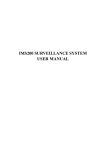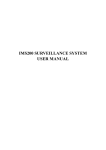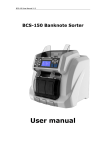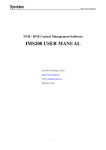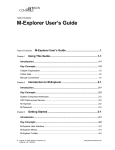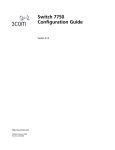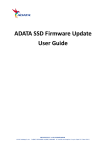Download IMS200 SuveillanceSystem User Manual
Transcript
MED RSS SURVEILLANCE SYSTEM USER MANUAL V1.1.0 01.2015 © Copyright Adata Ltd ®. All documentation rights reserved. PRECAUTIONS The contents of this manual may change due to product upgrades or for other reasons. We have the right to make changes of the contents without notice. This user manual is for reference only, subject to available products. This manual may contain inaccurate data or printing error. We reserve the right to interpret the details of this manual. PERFACE MED RSS Surveillance System User Manual introduces the software features and configuration operation of MED RSS. Please go through this user manual before operating. Agreements 1. Symbols: Index Meaning [] “[]” refers interface, menu and data sheet, e.g. “[Add User] interface” 【】 “【】” refers button, e.g. “click【OK】” Form 0-1 Important note: make some complement explanation to the contents. Warning: prompt the warning in order to avoid damage caused by improper operation. Note: prompt operation notes in order to avoid data loss and device damage caused by improper operation. © Copyright Adata Ltd ®. All documentation rights reserved. TABLE OF CONTENTS 1 INTRODUCTION ........................................................................................................... 1 1.1 SUMMARY .......................................................................................................... 1 1.2 RUNTIME ENVIRONMENT ................................................................................. 1 2 INSTALLATION ............................................................................................................. 3 2.1 WINDOWS OPERATION SYSTEM ..................................................................... 3 3 LOGIN AND INTERFACES ........................................................................................... 6 3.1 LOGIN ................................................................................................................. 6 3.2 3.3 INTERFACE ........................................................................................................ 7 QUICK GUIDE ................................................................................................... 13 4 FUNCTIONS................................................................................................................ 19 4.1 MONITOR.......................................................................................................... 19 4.2 QUERY .............................................................................................................. 27 4.3 ALARM .............................................................................................................. 40 4.4 PTZ CONTROL ................................................................................................. 53 4.5 MONITOR PROJECT ........................................................................................ 58 4.6 EMAP ................................................................................................................ 63 4.7 DEVICE STATE ................................................................................................. 66 4.8 USE-DEFINED TOOL........................................................................................ 66 4.9 DEVICE RUNNING ........................................................................................... 67 4.10 UPPER RIGHT ICONS ...................................................................................... 68 4.11 CPU & NETWORK ............................................................................................ 69 4.12 DATE & ALARM & LOG ..................................................................................... 69 5 SYSTEM SETTINGS ................................................................................................... 70 5.1 LOG ................................................................................................................... 70 5.2 LOCAL SET ....................................................................................................... 71 5.3 5.4 5.5 6 ADMIN CONFIG ................................................................................................ 78 INPUT/OUTPUT ................................................................................................ 90 MODIFY PASSWORD ....................................................................................... 90 APPENDIX A ............................................................................................................... 91 6.1 FAQ ................................................................................................................... 91 © Copyright Adata Ltd ®. All documentation rights reserved. 1 INTRODUCTION 1.1 SUMMARY The MED RSS software performs as a professional surveillance system you can use on your PC workstation, which supports multi-user, multi-window & multilingual display, voice talk, EMap, alarm, etc. MED RSS is compatible with various access devices. This is a stable, reliable and easy operation system. 1.2 RUNTIME ENVIRONMENT Hardware minimum requirements: CPU: P4/2.0GHz Memory: 512MB Graphics Resolution: 1024*768 and ≥128M memory (support DirectX 8.0 and higher grade) Hard Disk: 300MB free space Network transmission: 10/100Mbps Ethernet, consistent with TCP/IP or UDP/IP protocol Software minimum requirements: Operation system: Windows XP SP2, Windows 2000, Windows 2003, Windows Vista, win7(run by “Administrator” in Vista and win7),Mac OS Graphics drive installed © Copyright Adata Ltd ®. All documentation rights reserved. 1 Important note: enable “DirectX”, set the “hardware speed up” to ‘high’ © Copyright Adata Ltd ®. All documentation rights reserved. 2 2 INSTALLATION 2.1 WINDOWS OPERATION SYSTEM 1. Double left click “MED RSS_20141013.exe” to install this program. 2. Complete the installation following the guide, see “Diagram 2-1” to “Diagram 2-5” Step1: click “Next (N)”, see “Diagram 2-1 ” Diagram 2-1 Step2: click “Next (N)”after select a install path, the default installation path is “C:\Program Files\MED RSS”. See ”Diagram 2-2” © Copyright Adata Ltd ®. All documentation rights reserved. 3 Diagram 2-2 Step3: click “Next (N)” Diagram 2-3 © Copyright Adata Ltd ®. All documentation rights reserved. 4 Step4: install automatically Diagram 2-4 Step5: click “Finish (F)” to complete the installation process Diagram 2-5 © Copyright Adata Ltd ®. All documentation rights reserved. 5 3 LOGIN AND INTERFACES 3.1 LOGIN Double left click to pop up the [LOGIN] interface, see “Diagram 3-1”. Input the correct user name, password and click “OK” to enter the system. The default account is named “super”, which has a device management authority set upon it (the name and password are “super”). The default administration account is named “system”, which has authority to modify advanced functions like create new users, rights management and add E-map (the name and password are “system”). Please refer “5.3” for detail. Diagram 3-1 Note: 1. Modify your password in “Setting->Modify Password” after the first login. 2. Configure the organisation, users, device, EMap, etc. Please refer “5.3” for detail. © Copyright Adata Ltd ®. All documentation rights reserved. 6 3.2 INTERFACE There are live view screens, menus, functional keys, output mode keys, toolbar, upper right icons, alarm and status show on the main interface. (See “Diagram 3-2”). Diagram 3-2 1. Screens Display and control the real-time video. Select “voice talk”, “snapshot”, “record”, “output”, “save”, “go to” and “TV-wall” function in a specific window. (See “Diagram 3-3”) © Copyright Adata Ltd ®. All documentation rights reserved. 7 Diagram 3-3 Important note: functions are valid under specific conditions 2. Menu Name Function & Operation Shows organisations, devices and channels Shows device IP, name and model by moving the mouse cursor on a device Set the TV wall output and video output in to the center Status icons in record and live view mode Camera Lis Show the recording device’s status Record audio from Talk Search information of device and channel Add to “Favorite” Record review Position to playback Timing © Copyright Adata Ltd ®. All documentation rights reserved. 8 Reboot Log in / Log out (manually) Configure control Eight-direction control Control 3D positioning, simulated joystick, etc zoom Modify step, zoom, focus and Iris PTZ Ctrl Preset Auto Tour Aux Configure and execute presets Configure and execute auto tour Light, Aux1, Aux2, etc Configuration and Execution Plan the task Monitor Pause/On the task Project Import/Export the documents The information of the project and task Function authorisation (license password is necessary for License login) Set the record path Set the download path Set the snapshot path Set the talk path Set the single file length Enable the talk saving Setting Local Set Enable the display toolbar Show or hide the device name on EMap Minimum or maximum EMap size Set log number capacity Select media transfer protocol Select start screen numbers Set organisation levels © Copyright Adata Ltd ®. All documentation rights reserved. 9 Multi-window configuration Auto task running Select system startup mode Set time period before turn to the playback Time verification interval Time verification disparity Display content when device is running Language(Chinese/English) Screen display: OSD configuration Keyboard serial port configuration Admin config: configure the organisation, users, device, EMap and system Upgrade: software upgrade About: software version and copyright Add/modify/delete the users or devices Admin Add/edit the EMap Config System setting, I frame, log, authorization, password, DDNS setting. Input Input the setup file Output Output the setup file Modify Modify license password or current account password Password License For different users access for setting Custom Tool Playback the last alarm related video Status IP, manufacturer and working status information display. Display Form 3-1 © Copyright Adata Ltd ®. All documentation rights reserved. 10 3. Functional keys Name Description Task config Add, modify and delete tasks Plan config Add, modify and delete plan Global config Configure the external, detect, loss and cover alarm Relate config Configure the relate, alarm output to CDS/VMS/sound/SMS Alarm Manually plan Manually channel, device and node plan config Overall config Alarm, relate sound, relate light, relate output Execute Execute or stop task or plan Import/Export Import/export alarm information files Device info Device list, name and task status Playback Four-window record playback, support slice, full screen, record, snapshot, synchronised play, forward and slow Download Download from head end device or centre records Search Search the files of voice talk, local record, snapshot and Query download EMap Alarm show Shows alarms by time, type, user and status EMap Integrate the map and video information Dev status Device Status Shows the channel stream and alarm task TV wall Set the screens output to TV wall TV Wall Form 3-2 4. Output mode Name Description Output Mode 1/4/6/8/9/13/16/25/36/Full Screen/Close All Windows Form 3-3 © Copyright Adata Ltd ®. All documentation rights reserved. 11 5. Display toolbar Name Description Toolbar on screen Icons for record, snapshot, color, voice talk, streaming , etc. Form 3-4 6. Upper right icons Name Description Exit Minimizing, maximizing window, license, lock, switch and exit current account Form 3-5 7. Alarm & Date Name Description Shortcut zoom Pop up system log and alarm interface by clicking the time and alarm icon Form 3-6 8. Status Name Description Status CPU and network running status Form 3-7 © Copyright Adata Ltd ®. All documentation rights reserved. 12 3.3 QUICK GUIDE Login via the “super” account and add devices. Click【Admin Config】to enter the interface seen below: Diagram 3-4 1. Add: select an organisation node in ① zone and add devices under this node in ② zone. Input the device data like type, manufacturer, name, IP and password in the pop-up window; then click 【Access Channel】to get the device channels and alarm channels automatically. Lastly click to finish the process. (the “Device Channel Count” and “Alarm Channel Count” automatically generates according to the device IP. (The default port: 8000.) See “Diagram 3-5”. © Copyright Adata Ltd ®. All documentation rights reserved. 13 Diagram 3-5 2. Modify: select a device and click icon to modify it’s information 3. Device Information: this window (See “Diagram 3-6”), which contains [Device Information], [Video Channel] and [Alarm Channel], will pop up when you select a device. © Copyright Adata Ltd ®. All documentation rights reserved. 14 Diagram 3-6 “ Diagram 3-7” is the [Video Channel] interface © Copyright Adata Ltd ®. All documentation rights reserved. 15 Diagram 3-7 Double left click a video channel to pop up the [Channel Information], see “Diagram 3-8”. You can modify channel name, pre-position and camera type. The camera type includes camera, dome camera and half dome camera (channel ID, channel type and channel number are the default values). © Copyright Adata Ltd ®. All documentation rights reserved. 16 Diagram 3-8 “Diagram 3-9” shows the [Alarm Channel] interface Diagram 3-9 Double left click an alarm channel to get a popup window, see “Diagram 3-10” © Copyright Adata Ltd ®. All documentation rights reserved. 17 Diagram 3-10 You can operate in main interface after completing the configuration. Important note: there are two sets of criteria that apply to the PTZ function: 1. ensure the connected device is a dome camera; 2. Select the right camera type. © Copyright Adata Ltd ®. All documentation rights reserved. 18 4 FUNCTIONS 4.1 MONITOR 4.1.1 CAMERA LIST [Camera List] shows the “Structure”, “IP Address”, “Device List”, “Favorite” and “History”.(See “Diagram 4-1”). Diagram 4-1 © Copyright Adata Ltd ®. All documentation rights reserved. 19 Operation: Node: Click to open the sub list. Click to close the sub list. Switch to live view: Select a screen and double left click a camera to start the live view in this selected screen. Or drag a camera/device/node to a screen to play. Device information: move the mouse cursor to DVR or IPC to show the device information like IP, name, manufacturer and model. Start talk: select a camera and enable the voice talk in context menu, click again to stop talk. Add to “Favorite”: select a node/camera/channel and add to favorite in context menu. Playback interface position: Select a camera and position it to the playback interface by context menu. Set “Playback before”: Setting—>Local Set—>Other EMap position: select a camera and position it to the EMap using the context menu Search: input device name or IP address to search Context menu: Right click a device to execute the operations; “add to favorite”, “timing”, “reboot”, “log in” and “config” © Copyright Adata Ltd ®. All documentation rights reserved. 20 Diagram 4-2 Right click a camera to execute the operations “talk”, “add to favorite”, “go to playback” and “go to EMap”. Diagram 4-3 4.1.2 LIVE VIEW Play the live view in selected window or drag a node or a device to a window to play. (See “Diagram 4-4”). © Copyright Adata Ltd ®. All documentation rights reserved. 21 Diagram 4-4 Important note: 1. The device with green spot refers that this camera in live view mode. 2. Select a window, the corresponding camera will be marked automatically. 3. Drag device to change the screen position; double left click to maximize the image (single screen), double left click to go back. Screen context menu: (See “Diagram 4-5”). © Copyright Adata Ltd ®. All documentation rights reserved. 22 Diagram 4-5 Functions Description. Control Explanation Window Show the window number Voice talk Start the voice talk (depending on the DVR function) Snapshot Snapshot in live image Record Save the video audio in local files Output Set the output audio and color Save Save the current window and camera as one task group Save the current video in “Favorite” Go to Position to playback or EMap TV Wall Send image to TV wall Close Close the selected window Form 4-1 © Copyright Adata Ltd ®. All documentation rights reserved. 23 4.1.3 RECORD Click【Record】in the context menu to start recording, click again to stop the operation. Set record path in [Setting]—>[Local Set]—>[Record]. Introduction : : recording, : device, : channel 4.1.4 SNAPSHOT Click【Snapshot】in the context menu to save one single image of the video. Path: Setting —> Local Set —> Record. The default path: C:\Program Files\MED RSS\PIC. Save format: .bmp. 4.1.5 COLOR You can modify brightness, contrast, saturation and hue in screen [context menu] —>[Output]—>[Color]. (see “Diagram 4-6”) © Copyright Adata Ltd ®. All documentation rights reserved. 24 Diagram 4-6 Important note: Resume: restore the last operation; Default: restore to the default status. This operation modifies the screen output but not the head-end cameras. 4.1.6 VOICE TALK Select【Voice Talk】in the context menu to access the live sound, click it again to quit. Important note: multiple channel voice talk not supported. The voice collector in DVR is necessary for apply this function. 4.1.7 GO TO Playback: play 10 minutes of footage before the actual recording (the default is 10mins, you can modify the length of time the pre-record is set to in “Setting”—>“Local Set” “Others”—>“Playback Before”). © Copyright Adata Ltd ®. All documentation rights reserved. 25 EMap: Use the EMap function to show where the cameras are in the building. 4.1.8 TV WALL Integration of a TV wall in the CCTV system is supported; please contact your security installation specialist for further information on how to do this. 4.1.9 PARTITION Partition options are first window, 1, 4, 6, 8, 9, 10, 13, 16, 20, 25, 36 windows, see “Diagram 4-7”. Diagram 4-7 Important note: the default partition is 4 windows 4.1.10 FULL SCREEN Full screen icon is (see “Diagram 4-8”) © Copyright Adata Ltd ®. All documentation rights reserved. 26 Diagram 4-8 Important note: 1. The right sided toolbar pops up as the cursor move on to the zoom function; it will hide as cursor move out and away from the zoom function. 2. The bottom toolbar pops up as the cursor move into this zoom function, it will hide as cursor move out and away from the zoom function. 3. Click “Esc” to exit. 4.1.11 CLOSE ALL WINDOW Click to close all screens. 4.2 QUERY “Query” includes “Playback”, “Download”, “Search” and “Alarm Show”. © Copyright Adata Ltd ®. All documentation rights reserved. 27 4.2.1 PLAYBACK Click【Query】to pop up the [Playback] interface (see “Diagram 4-9”). Diagram 4-9 Select a camera in “Organisation”-> select the “source” (all, device, platform) and “type” (all, external alarm, motion detect, general record)-> double left click the date to list all records from that day (the time band with color refers the different record types in that period). You also can choose any time period by dragging the red bar along the timeline, see “Diagram 4-10”. © Copyright Adata Ltd ®. All documentation rights reserved. 28 Diagram 4-10 Green: General Yellow: Motion Detect Purple: External Alarm Select the hour and minute separately and play the recorded footage. Click to synchronize the four windows’ record time with the selected specific window Important note: the prompt shown in “Diagram 4-11” will pop up if the search has failed to find footage. Diagram 4-11 “Diagram 4-12” shows the playback toolbar Diagram 4-12 Fast forward: x2, x3, x4, MAX times faster playback. © Copyright Adata Ltd ®. All documentation rights reserved. 29 Slow down footage speed: -2, -3, -4, MIN slow playback All the searched recording results will be listed in the , see “Diagram 4-13”. Diagram 4-13 The recording highlighted in the blue color is the one that will be currently playing. Double left click a recording in the list to play. Double left click a window to switch to full screen mode (see “Diagram 4-14”) and click again to exit. © Copyright Adata Ltd ®. All documentation rights reserved. 30 Diagram 4-14 4.2.2 SLICE Click to operate on the recordings that have been searched for in the following interface. See “Diagram 4-15” © Copyright Adata Ltd ®. All documentation rights reserved. 31 Diagram 4-15 1. Toolbar The operations include snapshot, pause, play, fast, slow, single frame and stop. Define the slice duration either by its before or after time period. There are 1, 2, 5, 10, 15, 20, 30mins time length for selecting. Note: the slice toolbar function and operation are similar to the recording playback toolbar. Please consult the instructions for the playback toolbar for reference. 2. Bottom slice image Click to set the slice duration’s before or after time period. The system will © Copyright Adata Ltd ®. All documentation rights reserved. 32 automatically run the slice process according to the settings chosen. See “Diagram 4-16” Diagram 4-16 The first eight slice images will be illustrated at the bottom of the screen. If there are more than eight slice pictures, there will be a floating arrow for scroll display. 3. Side slice image Left single click image, the pic will be enlarged and display the previous and next slice image at the same time. See “Diagram 4-17” © Copyright Adata Ltd ®. All documentation rights reserved. 33 Diagram 4-17 The main selected image will be displayed in the middle of the three image frames, the other two image frames are the image frames before and after the selected image. 4. Playback Double left click the slice image to playback the record video from the time point of this slice. See “Diagram 4-18” © Copyright Adata Ltd ®. All documentation rights reserved. 34 Diagram 4-18 5. Menu Exit the video slice and switch to playback, download, video search or alarm page. 4.2.3 DOWNLOAD Click to turn to the [Download] interface. (see “Diagram 4-19”) © Copyright Adata Ltd ®. All documentation rights reserved. 35 Return Diagram 4-19 Select a camera in device list first, then define the recording “source” (all, device, platform) and “type” (all, external alarm, motion detect, general record), lastly double left click the recording’s date to get the search results list. Select the record in the list directly or select by time that operate in the time slider. Right click or double left click to start the download. (See “Diagram 4-20”) Diagram 4-20 Set the recording path in [Local Set] interface, the record format is “.dad”. “Diagram 4-21” shows the record loading progress. © Copyright Adata Ltd ®. All documentation rights reserved. 36 Diagram 4-21 Input the start and end time, click ‘Start’ to download all the records in this period. Click ‘End’ to stop download. (See “Diagram 4-22”) Diagram 4-22 Important note: you cannot download and playback the same channel recordings at the same time. The system will stop the playback automatically when you start downloading. 4.2.4 SEARCH Click ‘Search’ to open the interface as “Diagram 4-23” shows. © Copyright Adata Ltd ®. All documentation rights reserved. 37 Diagram 4-23 Select a node or a camera in device list first, then define the “start time”, “end time”, “file type” (voice talk, local record, snapshot file, download file) and “user”, lastly click【Search】 to get the results in the right bottom list. You can play a recording by clicking the “Play” button or double right click the recording. (See “Diagram 4-24”) Diagram 4-24 You can recycle play the video recordings but not the snapshot file. © Copyright Adata Ltd ®. All documentation rights reserved. 38 4.2.5 ALARM SHOW Click to turn to the interface like “Diagram 4-25”. Diagram 4-25 Select a node or a camera in device list first; then define the “date”, “start/end time”, “user”, “alarm type” (all, video loss, external alarm, motion detect, camera masking, device disconnection, host alarm) and “status” (not confirm, confirm); at last click 【Search】to get the result list. The number of required recordings will show in the blank areas following the 【Search】button. © Copyright Adata Ltd ®. All documentation rights reserved. 39 4.3 ALARM The system supports six different alarm types (video loss, external alarm, motion detection, camera masking, device disconnection and host alarm). As soon as the alarm has been triggered, the DVR/NVR, to which the alarm’s sensors are connect to, will start to record footage to its HDD. The alarm response includes recording sound, recording video, highlighting on EMap where alarm has been triggered, live video sent to TV wall, PUSH notification output (SMS, voice message). Click ‘Alarm’ option to bring up the interface seen below in “Diagram 4-26”. Diagram 4-26 Top: toolbar (See “Diagram 4-27”) © Copyright Adata Ltd ®. All documentation rights reserved. 40 Diagram 4-27 Stop all relate: stop all alarm relates Import: import alarm configuration Export: export alarm configuration Confirm: confirm the alarm and stop all relates Click to change the device’s information format. Double left click a device to illustrate all the sub channels. You can rank the list by【View】on top. (See “Diagram 4-28”) Diagram 4-28 © Copyright Adata Ltd ®. All documentation rights reserved. 41 Left: device list and alarm detail information Right: device information Right click on the alarm icon: or and preview the relates. Right click the blank area on the screen to save the current status as an alarm task ( or choose a rank type. Bottom right of the screen shows the event list. Click to deploy the event list, as shown in “Diagram 4-29”. © Copyright Adata Ltd ®. All documentation rights reserved. 42 Diagram 4-29 Alarm configuration steps: Task There are FOUR methods to set task. The task icon will be in green as you set the task. 1. Manually right click on the camera/device/node to enable or stop the tasks. 2. Select the alarm type in device list, e.g. set the task for all the devices and alarm type of “134” group. 3. Right click on the alarm icons -- , , , to enable or stop the tasks. 4. Set a task first and tick the items. This is the most convenient way to set the task. Plan the time periods for different tasks. Please refer 4.3.1 TASK CONFIG, 4.3.2 PLAN CONFIG. © Copyright Adata Ltd ®. All documentation rights reserved. 43 Important note: to perform the stop task is the same method as to enable it. For more information on ‘Global config’ please refer chapter 4.3.4 GLOBAL CONFIG. For more information on ‘Relate config’, please refer to Chapter 4.3.3 RELATE CONFIG After you have set the task, global config and relate config, the alarm icons on screens will turn red when the alarm has been triggered. The alarm relates are: Sound: enable the function and select an audio file (format: .wav) TV wall: enable this function and the alarm video will be sent to the TV wall when the alarm is triggered. Alarm interface: enable the function and the alarm interface will pop up when the alarm is triggered. (See “Diagram 4-30”). Diagram 4-30 © Copyright Adata Ltd ®. All documentation rights reserved. 44 Relate the alarm video; supports a maximum of 4 channels. (See “Diagram 4-31”) Red Flag Diagram 4-31 On the popup screen, you will find a voice talk icon to apply this function. (See “ Diagram 4-32”). Diagram 4-32 © Copyright Adata Ltd ®. All documentation rights reserved. 45 Important note: 1. The flagged alarm record will play the related video. 2. Double left click the alarm record to check the related video when there are more than one alarms are triggered. 3. Turn to the next or previous video by using the up and down icons. 4. Click “Confirm” to end the video relate function. 5. Double left click to full screen this window. The alarm icon will show on the screen when the alarm is triggered Diagram 4-33 KEY: : Motion detect; : video loss; : camera masking; : external alarm If you have already set up the alarm relates’ EMap, the map with alarm indicators will pop up when the alarm is triggered. (See “Diagram 4-34”) © Copyright Adata Ltd ®. All documentation rights reserved. 46 Diagram 4-34 SMS output and talk output are selectable. Alarm records will be sent to your phone by SMS or output by sound device. 4.3.1 ALARM TASK CONFIG Click【Alarm】-> 【Task Config】to pop up the interface as “Diagram 4-35”. © Copyright Adata Ltd ®. All documentation rights reserved. 47 Diagram 4-35 Click【New】to name a task; then select devices for alarm task by button; at last save the configuration as a new task. Click to edit and enable the alarm type. Click【Delete】to delete a task. Important note: the running tasks are still valid after you restart the system. 4.3.2 ALARM PLAN CONFIG Set plans to apply the tasks in particular time periods. Click【Alarm】-> and then【Plan Config】to pop up the interface as “Diagram 4-36”. © Copyright Adata Ltd ®. All documentation rights reserved. 48 Diagram 4-36 Plans will be automatically canceled when all the tasks are canceled from the list. 4.3.3 RELATE CONFIG Click【Alarm】-> 【Relate Config】to pop up the interface as “Diagram 4-37”. © Copyright Adata Ltd ®. All documentation rights reserved. 49 Diagram 4-37 Select the device in list and add it to the relate list. (See “Diagram 4-38”) Diagram 4-38 Tick the alarm type which includes sound relate, TV wall relate, EMap relate, and alarm interface relate. Click the camera【Config】option to pop up the window shown in “Diagram 4-39”. © Copyright Adata Ltd ®. All documentation rights reserved. 50 Diagram 4-39 Click the【Output】option to configure the SMS output and talk output. (See “Diagram 4-40”) Diagram 4-40 © Copyright Adata Ltd ®. All documentation rights reserved. 51 4.3.4 GLOBAL CONFIG Click【Alarm】-> then the【Global Config】option to pop up the following interface which include motion detect, cover, video loss, external alarm, host alarm and disconnection alarm. Diagram 4-41 Audio: enable or disable the function. You can select sound and set duration. The audio format is WAV. Video: enable or disable the video relate. Set popup video duration. Assist (e.g. light): enable or disable the assist devices and set the devices start time © Copyright Adata Ltd ®. All documentation rights reserved. 52 Alarm interface: enable the popup alarm interface Output: enable or disable the alarm output Important note: Any changes made in the ‘Global config’ options will be implemented to the whole security system. You have to enable the alarm relate before you can setup the SMS alarm alert and talk output functions. 4.4 PTZ CONTROL Open the PTZ interface to operate a PTZ camera connected to the system. To set step, zoom, focus, iris, preset, auto tour, aux, etc. Click【PTZ Ctrl】to open the toolbar, which is shown below in “Diagram 4-42”. Diagram 4-42 © Copyright Adata Ltd ®. All documentation rights reserved. 53 KEY: PTZ Controls Control Direction key Explain Up,down,left,right,upper left,upper right,lower left,lower right 8 direction SIT Single click on this button and the PTZ camera’s view will automatically reset to its most central position. Supports up to 36x zoom in/out function. To enlarge the selected screen (zoom in) drag mouse cursor from the bottom-up, and vice versa to zoom out from the footage of the screen (only controlled by mouse). Simulate Enable this function to be able to control the step and camera movement joystick by using the simulated joystick. Use the scroll wheel to control the camera zoom. Step There are 1-8 step degrees Zoom Control the camera zoom Focus Modify the definition and sharpness of the video footage Iris Preset Modify the brightness of the video image When the PTZ camera moves to the target position, input the preset number and save it so you move the camera back to that target position when you select the preset. Auto tour Aux Auto tour lines Turns on/off PTZ camera’s light (if light feature available) Form 4-2 © Copyright Adata Ltd ®. All documentation rights reserved. 54 4.4.1 PRESET Click【PTZ】-> [PRESET] ->【Setup】and the preset menu window will pop up, see “Diagram 4-43” below. Input the number, name and save this preset. Diagram 4-43 Diagram 4-44 Important note: preset numbers range between 1-128, you can name each preset using either numbers, letters or symbols. The maximum length of the preset name is 16 characters. Select a preset and click【Delete】to cancel it. Refer back to the PTZ controls; select a preset form the list, as shown in “Diagram 4-45” then click【Go To】to control the camera’s motion. © Copyright Adata Ltd ®. All documentation rights reserved. 55 Diagram 4-45 4.4.2 AUTO TOUR Click【PTZ】->[CRUISE]->【Setup】to pop up the auto tour window as shown in “Diagram 4-46”. This menu will allow you to setup a repeating movement sequence on the PTZ camera. Diagram 4-46 1. Click【New】to add a tour. (See “Diagram 4-47”) © Copyright Adata Ltd ®. All documentation rights reserved. 56 Diagram 4-47 2. Modify tour name, if required. 3. Select preset in the list and add it into tour setup. The maximum presets are 100 in one tour. 4. Double left click on the ‘Stay time’ to modify, the limit is 3-6000 seconds. The default is 5 seconds. 5. Select a preset in the tour and click to cancel/remove it from this tour. 6. 【Up】and【Down】is used for changing the preset sequence and the tour line. 7. Click【Save】to complete the setting The【Modify】operation is the same as adding a new tour routine 【Delete】is used to delete a tour Click【Exit】to quit Important note: you can add several presets into a tour at one time. © Copyright Adata Ltd ®. All documentation rights reserved. 57 Refer back to the PTZ controls, select a tour (See “Diagram 4-48”) and click “Go Preset” to execute the tour. Diagram 4-48 Important notes: 1. The PTZ controls only works for motorised movement speed domes or rotatable cameras; they are useless for normal camera non-PTZ. 2. You will need system password authorization to apply this function. 4.5 MONITOR PROJECT The operations in ‘Monitor project’ include task & plan config, pause & resume project, import & export, run & stop tasks. © Copyright Adata Ltd ®. All documentation rights reserved. 58 4.5.1 TASK CONFIG “Task” is the sub item of “Save” in screen contact menu. (Highlighted by the red box in “Diagram 4-49”). Diagram 4-49 Add new task: In the popup window, firstly input the task title and select the screen number (1,4,6,8,9,13,16,20,25,36), then select the node or device and add it into the task sub item list. Click ‘Save’ to complete the operation. © Copyright Adata Ltd ®. All documentation rights reserved. 59 Diagram 4-50 All the channel information is listed in the ‘Task SubItem’ section to the Task Config menu. In the same menu like the device, channel, camera ID, stop duration (10-3600s), preset (1-128) and stream information is also displayed. Click to cancel the channel from tasks. New: add a new task Modify: modify the task configuration Stay time: the default is 20 seconds. Double left click to modify the time between 10-3600 seconds. Preset: double left click to add preset number Save: save the configuration Cancel: cancel the select item Exit: quit this window © Copyright Adata Ltd ®. All documentation rights reserved. 60 Important note: 1. There can be a maximum of 100 devices in one task 2. Add all the devices on one node into the task by selecting the node. 3. Modify one stay time and apply this time to all in context menu 4.5.2 PLAN CONFIG “Diagram 4-51” is the ‘Plan Config’ interface. Click “Add” and modify the plan parameter like title, task start/end time. You can put the existing tasks into the plan. Diagram 4-51 Add several tasks into one plan, set the start and end time to make a cycle execution. Modify: modify the plan configuration Delete: delete a plan © Copyright Adata Ltd ®. All documentation rights reserved. 61 Exit: quit this window Important note: there are a maximum of 100 tasks in one plan In the monitor project interface, tick the box next to the task to carry it out. Diagram 4-52 Pause: pause and resume the running project Import: import tasks and plans list Export: export tasks and plans list Important note: the monitor project’s configuration is kept locally. Copy the © Copyright Adata Ltd ®. All documentation rights reserved. 62 configurations between devices via export data and then importing it to a new device. 4.6 EMAP EMap is used for showing the alarm, camera and device locations. “Diagram 4-53” shows the EMap interface Map organisational Minimize/Full structure screen/Close Camera search Cameras in the Video window map location Diagram 4-53 You can find camera, alarm and next level map icons on the map of the world. Double left click to view the next map level icon to turn to that particular map. Single click on a camera within the organizational device structure to get the camera location on map. Double left click the camera within list or upon the map to play the live view in left buttom screen. © Copyright Adata Ltd ®. All documentation rights reserved. 63 Diagram 4-54 Double left click the screen to turn to the full screen mode; double left click again or press “ESC” to quit. 【PTZ Control】: control the camera’s motion (if PTZ function is available on camera) 【Talk】: talk with front–end device 【Send】: send the video to playback window 【Stop】: stop the video playing : minimize the map : full screen the map. The icon highlighted green in “Diagram 4-55” is the full screen quit button © Copyright Adata Ltd ®. All documentation rights reserved. 64 Diagram 4-55 : close the map Important note: 1. Zoom in/out by using the scroll wheel 2. : triggered alarm : camera unconnected : device alarm triggered : device unconnected © Copyright Adata Ltd ®. All documentation rights reserved. 65 4.7 DEVICE STATE [Dev State] shows the current stream, motion detect, camera masking, video loss, external alarm states. (See “Diagram 4-56”) Diagram 4-56 1-16 is the channel number; : motion detect : camera masking : video loss : external alarm Important note: green icons mean that the function is on; red icons indicate that and alarm has been triggered. 4.8 USE-DEFINED TOOL Click in【Use-defined Tool】to check. © Copyright Adata Ltd ®. All documentation rights reserved. 66 4.9 DEVICE RUNNING ① Hard disk status(√: enable, Ⅹ: disable) ② Memory (red: full, blue: enough space) ③ Voice talk status ④ Recording status ⑤ Motion detect status status ⑦ Loss alarm status ⑧ External alarm status ⑥ Cover alarm (See “Diagram 4-57”) Diagram 4-57 © Copyright Adata Ltd ®. All documentation rights reserved. 67 4.10 UPPER RIGHT ICONS 4.10.1 MINIMIZE Click to hide the interface11 4.10.2 FULL SCREEN Click to switch to full screen mode. 4.10.3 SHUTDOWN Click to pop up the shutdown window. (Diagram 4-58) Diagram 4-58 Lock: lock the system. You need the password to unlock it. (See “Diagram 4-59”) Diagram 4-59 Switch On: the system will reboot as you click the “Switch On” button, then input the new © Copyright Adata Ltd ®. All documentation rights reserved. 68 username and password to login to your account. Exit: exit the system (power down system). Important note: When you login for the first time using the ‘System’ account login details, you will only have a limited set of authorities, which include ‘Live View’ monitoring, creating new login accounts and configuring them. Create your own account, with its own login details, and set the desired authorities to it. Reboot the system and login to your account with your newly created login details. 4.11 CPU & NETWORK CPU:wave range graph refers the CPU utilization amount being used by the system at the time. NET: refers to the net signal strength/speed 4.12 DATE & ALARM & LOG Displays the time, date, and number of alarms within the system. Click alarm number to view the alarm configuration interface, see 4.3 ALARM. Click date and time to pop up the system’s log interface. © Copyright Adata Ltd ®. All documentation rights reserved. 69 5 SYSTEM SETTINGS In this section you will able to find and configure local set, modify password, log, update, screen-out, virtual keyboard, license and admin config options in [Setting]. (See “Diagram 5-1”) Diagram 5-1 5.1 LOG Records account events, operations and alarm information to a system log. Search and download the records according to its time, type, device and username in 【LOG】interface. See “Diagram 5-2” © Copyright Adata Ltd ®. All documentation rights reserved. 70 Diagram 5-2 Important note: click【ALL LOG】to get the all records of the selected device 5.2 LOCAL SET “Diagram 5-3” shows the [Local Set] interface. You can set the record, display, system and some other parameter within this interface. © Copyright Adata Ltd ®. All documentation rights reserved. 71 Diagram 5-3 5.2.1 RECORDING SETTING Record (Diagram 5-3): modify recording, download path, snapshot path and talk path, set the single file length and enable the talk save. 5.2.2 DISPLAY SETTING Display (Diagram 5-4): enable the toolbar and EMap’s device name, set the map size, log number and media transfer protocol. © Copyright Adata Ltd ®. All documentation rights reserved. 72 Diagram 5-4 Important note: suggest UDP protocol for internal local area network; TCP protocol for a wide area Ethernet. 5.2.3 SYSTEM SETTING System (Diagram 5-5): set start screen mode (the options include: 1\4\6\8\9\10\13\16\20\25\36), organisation level, multi-window config (main interface, query, EMap and alarm), auto task running config, and system startup mode. © Copyright Adata Ltd ®. All documentation rights reserved. 73 Diagram 5-5 Set the start screens as per your requirement; Set a multi-level structure, like “country->province->city->street” 4 levels. Enable the task auto running; System startup mode: you can alternate between full screen and exclusive area views; Multi-window config; set to display either the Main, Query, Map and Alarm interface. See “Diagram 5-6” © Copyright Adata Ltd ®. All documentation rights reserved. 74 Diagram 5-6 5.2.4 OTHERS Others (Diagram 5-7): set playback forward time, interval, disparity, device running and language. © Copyright Adata Ltd ®. All documentation rights reserved. 75 Diagram 5-7 5.2.5 SCREEN OUT To set the OSD background color and text color. Diagram 5-8 shows the [Screen Out] interface Diagram 5-8 © Copyright Adata Ltd ®. All documentation rights reserved. 76 Click “OSD BackColor” and “OSD TextColor” to set color You can also set the “OSD Text Size”, “OSD Position” and “OSD Visible” If OSD is visible, the information will show on the upper left, see “Diagram 5-9” Diagram 5-9 5.2.6 VIRTUAL KEYBOARD The virtual keyboard (appears within the interface, and viewable via the monitor), can work alongside a physical keyboard connected to the workstation where MED RSS is installed upon. Please consult technical support staff for further details. © Copyright Adata Ltd ®. All documentation rights reserved. 77 Diagram 5-10 5.3 ADMIN CONFIG Click【Admin Config】to enter the interface,see”Diagram 5-11 Diagram 5-11 There are “Organisation”, “EMap” and “System” options in [Admin Config]. 5.3.1 USERS & DEVICE Click【Organisation】to enter the following interface: © Copyright Adata Ltd ®. All documentation rights reserved. 78 Diagram 5-12 ① List of the organisational structure. You can add, modify and delete nodes here and click a node to open the sublist (only the “system” account has the authority to operate). ② This section contains the users and the devices attached to the system. You can add, modify and delete users and devices here. 1. Users Add: select a node and click to pop up the following interface Diagram 5-13 Modify: select a user and click License: the [Device List] (Diagram 5-14) will pop up when you select one user. icon to modify user information Tick the device or channel to in the list to authorise and click © Copyright Adata Ltd ®. All documentation rights reserved. to save the modify. 79 Diagram 5-14 Delete: select a user or a device you want to delete and click 2. Device Add: select an organisation node and click to add device in this node. Input the device data in the popup window and click to finish the process (the “Device Channel Count” and “Alarm Channel Count” auto generate according to the device IP). See”Diagram 5-15”. © Copyright Adata Ltd ®. All documentation rights reserved. 80 Diagram 5-15 Modify: select a device and click its icon to modify the information Device Information: the interface, which contains [Device Information], [Video Channel] and [Alarm Channel] will pop up when you select a device. See “Diagram 5-16” © Copyright Adata Ltd ®. All documentation rights reserved. 81 Diagram 5-16 Diagram 5-16 is the [Device Information] interface Diagram 5-17 is the [Video Channel] interface Diagram 5-17 Double left click a channel to pop up [Channel Information], see “Diagram 5-18”. You can modify channel name and type in [Channel Information]. The camera type include camera, PTZ dome camera and dome camera. © Copyright Adata Ltd ®. All documentation rights reserved. 82 Diagram 5-18 “Diagram 5-19” shows the [Alarm Channel] interface Diagram 5-19 Double left click an alarm channel to see the popup window, see “Diagram 5-20” © Copyright Adata Ltd ®. All documentation rights reserved. 83 Diagram 5-20 5.3.2 EMAP Click【Admin Config】then the【EMap】option to bring up the following interface: © Copyright Adata Ltd ®. All documentation rights reserved. 84 Diagram 5-21 Two parts: ① This section to the interface allows the user to manage the EMAP’s content. This includes adding, modifying and deleting nodes. ② This is the map management & zoom screen. You can add cameras and alarms on to the map, and even drag or modify the map size. Cancel Save Delete Show device : delete the unsaved node on map : save the operations : delete selected records or cameras on the map : pops up the device list and so that you can drag the cameras or alarms on to the map, click to save the operation. (see “Diagram 5-22”) © Copyright Adata Ltd ®. All documentation rights reserved. 85 Diagram 5-22 Show node : show the nodes on map, see “Diagram 5-23” © Copyright Adata Ltd ®. All documentation rights reserved. 86 Diagram 5-23 Tick/select the node you want to place on map. Click the ‘+’ symbol on the lower right hand side to open the sub-map, you can position on the sub-map. (see “Diagram 5-24”) © Copyright Adata Ltd ®. All documentation rights reserved. 87 Diagram 5-24 5.3.3 SYSTEM Click【System】to enter the interface as “Diagram 5-25” © Copyright Adata Ltd ®. All documentation rights reserved. 88 Diagram 5-25 Sections included within this option window include; I frame, log, authorization, password and DDNS in system management module, which is only shows when the “system” account login is used. I Frame: enable and insert a I frame when start live view or playback for improving image fluency. Log: log will be deleted when it exceeds the storage period limitation. Password: you can modify password; only when you are logged in as ‘System’ administrator only. DDNS: supports DDNS © Copyright Adata Ltd ®. All documentation rights reserved. 89 5.4 INPUT/OUTPUT Input and output the data from the【SETTING】options like the local settings, admin config and log. 5.5 MODIFY PASSWORD 1. In the [Modify Password] interface, type in the old password and then type in the new password twice to modify (second time to confirm). Modify the system password in “Setting”—> “Admin Config”—> “System”—> “System Password”. Diagram 5-26 2. Modify the authorization password by inputting the old password and typing in the new one twice to modify (second time to confirm). Modify the authorization password in Setting—>Admin Config—>System—>Authorization. Diagram 5-27 © Copyright Adata Ltd ®. All documentation rights reserved. 90 6 APPENDIX A 6.1 FAQ Q: What does it mean when the prompt “Video Open Fail” shows in live view or tour mode? A: Possible reasons: 1. The device has a system error and may have an internal system breakdown. 2. Network connection has failed – there may be a fault in the network. Q: P/T/Z camera cannot be controlled? A: Possible reasons: 1. Ensure the camera has a P/T/Z function 2. Enable the P/T/Z function 3. Configure the compatible protocol and address code, check the RS485 connections on both the camera and DVR/NVR device. Make sure the cable connections are using the correct “+”“—” ports. © Copyright Adata Ltd ®. All documentation rights reserved. 91 For more information about our DVRs and available cameras & accessories, please visit our website: www.adata.co.uk Alternatively scan this QR code with your smart phone to be directed instantly to our website: Download our mobile apps to remotely operate your DVR on the move. © Copyright Adata Ltd ®. All documentation rights reserved. 92































































































